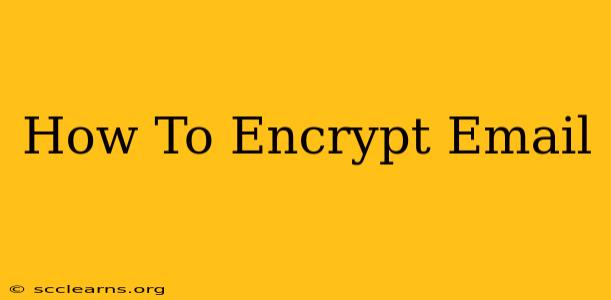In today's digital world, email security is paramount. Protecting your sensitive information from prying eyes is crucial, and email encryption is the key. This comprehensive guide will walk you through various methods of encrypting your emails, ensuring your private communications remain private.
Why Encrypt Your Emails?
Before diving into the how, let's understand the why. Why should you bother encrypting your emails? Simply put, because unencrypted emails are easily intercepted and read by unauthorized individuals. This includes hackers, government agencies (depending on your location and laws), and even your internet service provider. Encrypting your emails ensures that only the intended recipient can read your message. This is especially vital when sending:
- Confidential financial information: Bank details, credit card numbers, and investment strategies.
- Sensitive personal data: Medical records, social security numbers, and passport details.
- Private communications: Personal emails, business proposals, and legal documents.
Methods for Email Encryption
There are several ways to encrypt your emails, each with its own advantages and disadvantages. Let's explore the most popular options:
1. Using Email Providers with Built-in Encryption
Some email providers, such as ProtonMail and Tutanota, offer end-to-end encryption by default. This means that your emails are encrypted before they leave your device and decrypted only by the recipient's device. This offers a high level of security with minimal user effort. However, you need to use that specific email provider.
Advantages: Simple to use, strong security. Disadvantages: Requires switching email providers; may not be compatible with all recipients.
2. S/MIME Encryption
S/MIME (Secure/Multipurpose Internet Mail Extensions) is a widely used standard for encrypting and digitally signing email messages. It uses digital certificates to verify the sender's identity and encrypt the email content. While offering strong security, setting up S/MIME can be more technical and requires obtaining and managing digital certificates. Your email client may already have S/MIME capabilities.
Advantages: Widely supported, strong security, digital signatures for authentication. Disadvantages: More complex setup, requires digital certificates.
3. PGP/GPG Encryption
PGP (Pretty Good Privacy) and GPG (GNU Privacy Guard) are open-source encryption programs that provide a high level of security. They use a public-key cryptography system, where you have a public key (which you share with others) and a private key (which you keep secret). Messages encrypted with your public key can only be decrypted with your private key.
Advantages: Strong security, open-source, cross-platform compatibility. Disadvantages: Steeper learning curve, requires managing keys, not as user-friendly as built-in encryption.
4. Encrypting Attachments Separately
If you're only sending sensitive information as an attachment, consider encrypting the attachment itself using a strong encryption tool before attaching it to your email. There are many file encryption tools available, both free and paid. This offers an extra layer of security, even if the email itself isn't encrypted.
Advantages: Simple, adds an extra layer of security to attachments. Disadvantages: Does not protect the email body, still requires the email to be sent.
Choosing the Right Encryption Method
The best email encryption method for you depends on your needs and technical skills. If simplicity is your priority, using an email provider with built-in encryption is the easiest option. For maximum security and control, PGP/GPG might be a better choice, although it requires more technical expertise. S/MIME offers a middle ground between simplicity and security. Encrypting attachments separately is a good supplementary security measure.
Remember: No encryption method is foolproof. Always exercise caution when sending sensitive information online, and keep your software updated with the latest security patches. Using a strong password is essential, regardless of the encryption method used. Staying informed about email security best practices is also crucial in maintaining your online privacy.

